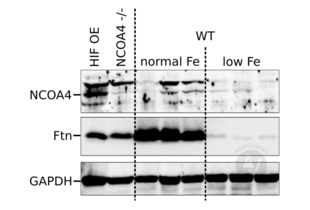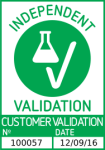NCOA4 anticorps (N-Term)
-
- Antigène Voir toutes NCOA4 Anticorps
- NCOA4 (Nuclear Receptor Coactivator 4 (NCOA4))
-
Épitope
- N-Term
-
Reactivité
- Humain, Souris, Rat, Boeuf (Vache), Chien, Cheval, Cobaye, Lapin
-
Hôte
- Lapin
-
Clonalité
- Polyclonal
-
Conjugué
- Cet anticorp NCOA4 est non-conjugé
-
Application
- Western Blotting (WB)
- Séquence
- CLIHQLEYTQ NKDLANQVSV CLERLGSLAL KPEDSTVLLF EADTSALRQT
- Homologie
- Cow: 92%, Dog: 93%, Guinea Pig: 100%, Horse: 93%, Human: 100%, Mouse: 100%, Rabbit: 100%, Rat: 100%
- Attributs du produit
- This is a rabbit polyclonal antibody against Ncoa4. It was validated on Western Blot.
- Purification
- Affinity Purified
- Immunogène
- The immunogen is a synthetic peptide corresponding to a region of Mouse
- Top Product
- Discover our top product NCOA4 Anticorps primaire
-
-
- Indications d'application
- Optimal working dilutions should be determined experimentally by the investigator.
- Commentaires
-
Antigen size: 625 AA
- Restrictions
- For Research Use only
-
- by
- University of Michigan Medical School, Molecular & Integrative Physiology, Shah lab
- No.
- #100057
- Date
- 12.09.2016
- Antigène
- Ncoa4
- Numéro du lot
- QC11327
- Application validée
- Western Blotting
- Contrôle positif
- HIF overexpression mice, WT mice
- Contrôle négative
- NCOA4-/- mice
- Conclusion
- Passed, based on the fact that the antibody picked up the positive control (unpublished data suggests that NCOA4 is highly expressed in an intestinal HIF overexpression model).
- Anticorps primaire
- ABIN2780237
- Anticorps secondaire
- Anti-rabbit HRP-linked secondary antibody (Cell Signaling, 7074S, lot 26)
- Full Protocol
- Wild type (WT) or NCOA4 -/- mice were fed normal or iron-deficient diet for 7 days, followed by euthanization and scraping of duodenal epithelium (DE).
- DE cells were lysed in RIPA buffer and whole cell lysate (WCL) prepared.
- 50µg total protein from each sample were used for Western blot analysis.
- Samples were denatured in 5x gel-loading buffer containing beta-marcaptoethanol and separated on a 10% SDS-PAGE gel (Laemmli 1970).
- Transfer onto Nitrocellulose membrane (Biorad, 1620212, lot 10484060) was done on Trans-Blot SD apparatus (Bio-Rad) following the manufacturer’s protocol.
- Membranes were blocked with TBS-tween (TBST) solution containing 5% milk for 1h.
- Incubation with primary antibody overnight at 4°C:
- NCOA4 antibody ABIN2780237 (lot QC11327) diluted 1:1000 in TBST containing 0.1% BSA.
- FTH1 antibody (Cell signaling, 3998S; lot 1) diluted in TBST containing 0.1% BSA.
- GAPDH antibody (Santa Cruz, SC-25778, lot D30115) diluted in TBST containing 0.1% BSA.
- Washing with TBST for 15min at RT.
- Incubation with anti-rabbit HRP-linked secondary antibody (Cell Signaling, 7074S, lot 26) diluted 1:2000 in TBST a shaker for 1h at RT.
- Three rinses, followed by four 15min washes, twice TBST and twice with TBS.
- Chemiluminescence detection was done using ECL Select Western blotting detection reagent (Amersham, RPN2235, lot 9723881).
- Blot was developed on a Biorad imaging system.
- Notes
- The antibody did not consistently pick up the WT mice on normal and low iron diet.
- Also, there is still a faint band in the NCOA4 -/- lane. We are confident that it is a true KO mouse, as there is high ferritin expression even after 7 days of low iron diet (compared to ferritin expression in WT low iron mice as well as that of the HIF over expression mouse, which are known to have high intestinal ftn content).
Validation #100057 (Western Blotting)![Testé avec succès 'Independent Validation' signe]()
![Testé avec succès 'Independent Validation' signe]() Validation Images
Validation Images![Mouse duodenum whole cell lysates from intestinal HIF overexpression (HIF OE) mice, NCOA4-/- mice, and wt mice fed a normal or low iron diet were separated by SDS-PAGE. NCOA4 was visualized using ABIN2780237. A ferritin (Ftn) Western blot was done to confirm the efficacy of iron diet regimens in mice. GAPDH served as loading control.]() Mouse duodenum whole cell lysates from intestinal HIF overexpression (HIF OE) mice, NCOA4-/- mice, and wt mice fed a normal or low iron diet were separated by SDS-PAGE. NCOA4 was visualized using ABIN2780237. A ferritin (Ftn) Western blot was done to confirm the efficacy of iron diet regimens in mice. GAPDH served as loading control.
Protocole
Mouse duodenum whole cell lysates from intestinal HIF overexpression (HIF OE) mice, NCOA4-/- mice, and wt mice fed a normal or low iron diet were separated by SDS-PAGE. NCOA4 was visualized using ABIN2780237. A ferritin (Ftn) Western blot was done to confirm the efficacy of iron diet regimens in mice. GAPDH served as loading control.
Protocole -
- Format
- Liquid
- Concentration
- Lot specific
- Buffer
- Liquid. Purified antibody supplied in 1x PBS buffer with 0.09 % (w/v) sodium azide and 2 % sucrose.
- Agent conservateur
- Sodium azide
- Précaution d'utilisation
- This product contains Sodium azide: a POISONOUS AND HAZARDOUS SUBSTANCE which should be handled by trained staff only.
- Conseil sur la manipulation
- Avoid repeated freeze-thaw cycles.
- Stock
- -20 °C
- Stockage commentaire
- For short term use, store at 2-8°C up to 1 week. For long term storage, store at -20°C in small aliquots to prevent freeze-thaw cycles.
-
- Antigène
- NCOA4 (Nuclear Receptor Coactivator 4 (NCOA4))
- Autre désignation
- Ncoa4 (NCOA4 Produits)
- Synonymes
- anticorps zgc:55307, anticorps zgc:77270, anticorps NCOA4, anticorps MGC138109, anticorps rfg, anticorps ele1, anticorps ptc3, anticorps ara70, anticorps MGC84996, anticorps DKFZp469A035, anticorps DKFZp459B2429, anticorps DKFZp469A1925, anticorps ncoa4, anticorps ARA70, anticorps ELE1, anticorps PTC3, anticorps RFG, anticorps 1110034E15Rik, anticorps 4432406M01Rik, anticorps AI227008, anticorps Rfg, anticorps nuclear receptor coactivator 4, anticorps nuclear receptor coactivator 4 S homeolog, anticorps Ncoa4, anticorps ncoa4, anticorps NCOA4, anticorps ncoa4.S
- Sujet
-
The function of Ncoa4 remains unknown.
Alias Symbols: 1110034E15Rik, 4432406M01Rik, AI227008, ARA70, MGC103382, Rfg
Protein Interaction Partner: Ndn,
Protein Size: 625 - Poids moléculaire
- 70 kDa
- ID gène
- 27057
- NCBI Accession
- NM_001033988, NP_001029160
- Pathways
- Intracellular Steroid Hormone Receptor Signaling Pathway
-


 (1 validation)
(1 validation)



